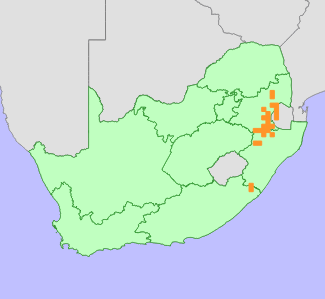|
Scientific Name | Aloe kniphofioides Baker |
Higher Classification | Monocotyledons |
Family | ASPHODELACEAE |
Synonyms | Aloe marshalli J.M.Wood & M.S.Evans |
Common Names | Grasaalwyn (a), Grass Aloe (e), Red Poker Grass Aloe (e) |
National Status |
Status and Criteria | Near Threatened B1ab(iii) |
Assessment Date | 2019/03/14 |
Assessor(s) | M. Lötter, J.E. Burrows, C. Craib, L. von Staden & D. Raimondo |
Justification | Aloe kniphofioides is a widespread (extent of occurrence 18 385-38 691 km²) species that has become rare due to 40% habitat loss. The severely fragmented population continues to decline due to ongoing habitat loss, degradation and competition from alien invasive plants. Therefore it nearly meets the thresholds for the category Vulnerable under the criteria B1ab(iii). |
Distribution |
Endemism | Not endemic to South Africa |
Provincial distribution | Eastern Cape, KwaZulu-Natal, Mpumalanga |
Range | This species occurs in high altitude grasslands of Mpumalanga, KwaZulu-Natal and north-eastern Eastern Cape, South Africa. It also occurs in western Swaziland. |
Habitat and Ecology |
Major system | Terrestrial |
Major habitats | Midlands Mistbelt Grassland, Northern KwaZulu-Natal Moist Grassland, Northern Escarpment Quartzite Sourveld, Barberton Montane Grassland, KaNgwane Montane Grassland, Paulpietersburg Moist Grassland, Wakkerstroom Montane Grassland, Eastern Highveld Grassland |
Description | It occurs in montane grassland. |
Threats |
| The habitat of Aloe kniphofioides is ideally suited to the cultivation of commercial timber plantations, and throughout its range, large areas of habitat has been converted to timber plantations, resulting in many localized extinctions. It has also suffered habitat loss to coal mining, rural settlements and subsistence agriculture, and overall, 40% of A. kniphofioides's habitat is already irreversibly modified.
Subpopulations in small fragments are impacted by inappropriate fire management, which leads to a loss of pollinators and poor recruitment (Craib 2005). Remaining habitat continues to be degraded due to overgrazing and spreading, unmanaged alien invasive plants, particularly wattles. Wattles outcompete native grassland species through shading and allelopathy.
The largest areas of intact suitable habitat, which occurs in a Protected Environment near Wakkerstroom, is threatened by coal mining. There are ongoing legal battles to overturn authorisation of mining within the Protected Environment. |
Population |
Aloe kniphofioides has a wide distribution range, but is rare across its range, occurring in scattered, small subpopulations. Most subpopulations persist in small, isolated grassland remnants, due to historical habitat loss and fragmentation. According to Craib (2005), A. kniphofioides used to be common in areas such as the Piet Retief and Lochiel districts in southern Mpumalanga, but by the 1980s these subpopulations were much reduced and fragmented by habitat loss to timber plantations. Recent (2000-2012) field observations indicate that it is still fairly common to the east of Wakkerstroom, where large areas of remaining habitat is protected in the KwaMandlangampisi and Pongola Bush Protected Environments. However, elsewhere within its range it is now very rare, and mostly only known through historical records.
A population decline of 10-16% over the past three generations is inferred from the rate of habitat loss recorded between 1990 and 2014. The species was last recorded in the Eastern Cape in 1920, and it may be locally extinct there.
|
Population trend | Decreasing |
Assessment History |
Taxon assessed |
Status and Criteria |
Citation/Red List version | | Aloe kniphofioides Baker | NT B1ab(iii) | 2020.1 | | Aloe kniphofioides Baker | VU A2c | Raimondo et al. (2009) | | Aloe kniphofioides Baker | Lower Risk - Least Concern | Scott-Shaw (1999) | |
Bibliography |
Craib, C. 2005. Grass Aloes in the South African Veld. Umdaus Press, Hatfield.
Raimondo, D., von Staden, L., Foden, W., Victor, J.E., Helme, N.A., Turner, R.C., Kamundi, D.A. and Manyama, P.A. 2009. Red List of South African Plants. Strelitzia 25. South African National Biodiversity Institute, Pretoria.
Scott-Shaw, C.R. 1999. Rare and threatened plants of KwaZulu-Natal and neighbouring regions. KwaZulu-Natal Nature Conservation Service, Pietermaritzburg.
Van Wyk, B.-E. and Smith, G. 2003. Guide to aloes of South Africa. (2nd ed.). Briza Publications, Pretoria.
|
Citation |
| Lötter, M., Burrows, J.E., Craib, C., von Staden, L. & Raimondo, D. 2019. Aloe kniphofioides Baker. National Assessment: Red List of South African Plants version . Accessed on 2025/05/19 |
 Comment on this assessment
Comment on this assessment

